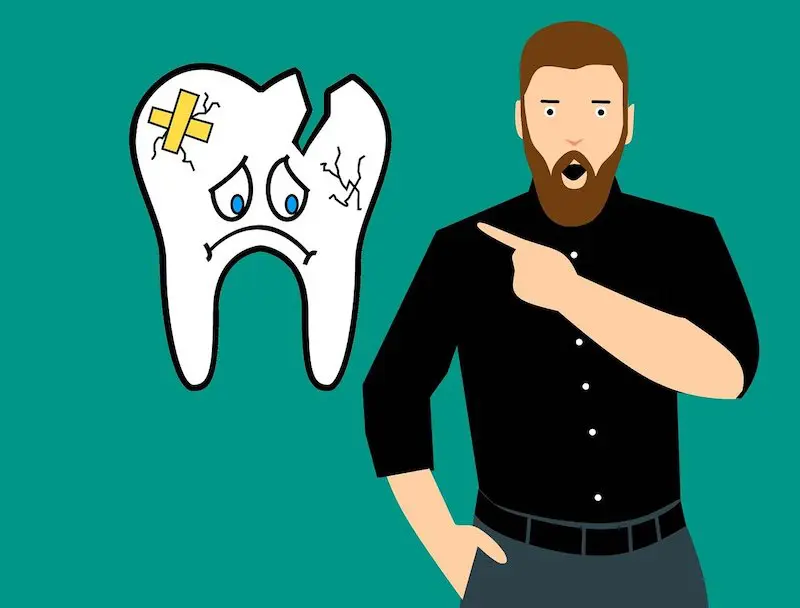Tooth enamel is one of the hardest substances in the human body, but it’s still possible to end up with a chipped tooth. Biting down on the wrong food, taking a blow to the mouth in a contact sport, and countless other instances can cause chips in tooth enamel.
So, what happens if you do chip a tooth? The good news is that there are ways to solve the problem. There’s a range of procedures available from experienced dentists to get your smile looking as good as new again. Here’s what you need to know.

(mohamed_hassan / pixabay)
Options for Fixing Chipped Tooth Enamel
The first step in dealing with chipped tooth enamel is visiting your dentist as quickly as possible. Your dentist will be able to assess the damage to your tooth and suggest possible treatments. Even if the tooth is at the back of your mouth and isn’t as visible, it’s important to get dental treatment to avoid issues like infections, pain, and further problems.
If your tooth enamel is only chipped very slightly, your dentist may be able to “recontour” the rest of the tooth to make it less visible. Common chip repair options include:
1. Dental Filling or Bonding
A minor crack impacting the outer tooth could be managed with dental bonding or filling treatments. A quick polish to the area can be all it takes to remove any rough spots. If you chip the enamel very slightly, your dentist can fill or bond the space. Bonding is a simple procedure that uses a tooth-colored composite resin to fill the gap.
The dentist applies resin to the tooth with adhesive material and shapes it to ensure that it blends with the rest of your natural tooth. The finish should last for several years.
2. Veneers
In many cases, dentists will apply veneers to the tooth’s front to treat the cracked surface. These are very thin resin composite or porcelain laminate products designed to cover the front section of the tooth. The treatment produces a natural, smooth look and may be helpful if the crack is more significant or you want to correct the shape and color of your cracked tooth. Veneers often look completely natural and can last for decades when treated with care.
3. Dental crowns
Another option for treating a broken tooth is using a dental crown. Crowns are essentially a tooth-shaped cap that slips over the surface of the tooth. This is usually the option a dentist will suggest if the damage to the tooth is severe. The dentist will need to grind away a portion of the remaining tooth and then apply a cap resembling your remaining teeth.
Applying a dental crown can be a more complex experience than the other treatments mentioned here. X-rays will be taken to determine the extent of your tooth damage. Your dentist will also need to make a permanent crown for you in a lab to get the perfect finish for your teeth.
4. Inlay and onlay
Inlays are cemented dental restorations that can repair multiple surfaces of a tooth (including the chewing surface). Your dentist might give you the option to choose between porcelain, gold, or other ceramic materials. Onlays are offered in the same materials and are also a cemented dental restoration.
An onlay covers one or multiple cusp tips while an inlay resides within the cusp of the tooth.
When are Root Canals Necessary?
A simple crack or chip to tooth enamel won’t require a complex procedure like a root canal in most cases. However, if the trauma caused to your tooth also damages the pulp of the tooth, or an infection infiltrates your tooth, root canal treatment will be necessary. If the tooth becomes more sensitive or changes color, this is a common sign that root issues are at play. Dentists will need to remove the inner tissues of the tooth. Once the tooth is fully removed, it will be possible to replace it with a bridge or a new dental implant.
Can a tooth enamel repair itself?
Yes, but only when the damage is minimal. For instance, a tooth with a minimal fracture line and crack on the external repair may repair itself without dental intervention. The process relates to the minerals in our mouth and is professionally referred to as remineralization.
Saliva plays a significant role in keeping our mouths healthy and can help to restore the cracked tooth enamel to its protective and strong state. It’s crucial to watch your food intake and reduce sugar consumption to speed up the remineralization process. Using fluoride toothpaste might also help.
Is it Crucial to Replace a Chipped Tooth?
Even if you don’t think that your chipped tooth enamel is noticeable, it is important to visit your dentist as soon as possible. Though the chip might seem painless at first, it will make your tooth weaker and more susceptible to long-term damage. Failure to get treatment fast enough could mean that a small chip turns into a major issue for your teeth.
Fixing a chipped tooth early can save you the pain and expense of more comprehensive treatment, like a root canal. Our family dentists in Weber and Davis counties can help restore your enamel back to its pre-chipped state with industry-leading techniques. Contact us today for a dental examination — we’ll do our best to get you a new smile that’ll boost your look and confidence.
